Podcast
Questions and Answers
Ferdows' research on international production builds upon the work of Bartlet and Ghoshal by specifically addressing which dimension of subsidiary evolution?
Ferdows' research on international production builds upon the work of Bartlet and Ghoshal by specifically addressing which dimension of subsidiary evolution?
Which of the following is LEAST aligned with Ferdows' arguments regarding the evolving role of international production subsidiaries?
Which of the following is LEAST aligned with Ferdows' arguments regarding the evolving role of international production subsidiaries?
In Ferdows' Strategic Matrix, a 'Lead' factory is characterized by high site competence and which primary strategic reason?
In Ferdows' Strategic Matrix, a 'Lead' factory is characterized by high site competence and which primary strategic reason?
What is the key differentiating factor between a 'Source' factory and an 'Offshore' factory according to Ferdows' framework?
What is the key differentiating factor between a 'Source' factory and an 'Offshore' factory according to Ferdows' framework?
Signup and view all the answers
A 'Contributor' factory and a 'Server' factory both prioritize proximity to market. What distinguishes a 'Contributor' factory from a 'Server' factory in Ferdows' model?
A 'Contributor' factory and a 'Server' factory both prioritize proximity to market. What distinguishes a 'Contributor' factory from a 'Server' factory in Ferdows' model?
Signup and view all the answers
Which factory type in Ferdows' framework is most closely associated with the 'black hole' subsidiary described in some international business literature, focused on intelligence gathering?
Which factory type in Ferdows' framework is most closely associated with the 'black hole' subsidiary described in some international business literature, focused on intelligence gathering?
Signup and view all the answers
According to Ferdows, the 'upgrading' process for foreign factories involves resource recombination across three stages. Which of the following sequences accurately represents these stages?
According to Ferdows, the 'upgrading' process for foreign factories involves resource recombination across three stages. Which of the following sequences accurately represents these stages?
Signup and view all the answers
Which of the following is presented as a significant barrier to the 'upgrading' of foreign factories in the provided text?
Which of the following is presented as a significant barrier to the 'upgrading' of foreign factories in the provided text?
Signup and view all the answers
Which of the following critiques is LEAST aligned with the text's discussion of Ferdows' perspective on factory roles?
Which of the following critiques is LEAST aligned with the text's discussion of Ferdows' perspective on factory roles?
Signup and view all the answers
According to the critique of Ferdows, what potential negative consequence can arise from multinational enterprises frequently shifting production locations in response to exchange rate fluctuations and wage differentials?
According to the critique of Ferdows, what potential negative consequence can arise from multinational enterprises frequently shifting production locations in response to exchange rate fluctuations and wage differentials?
Signup and view all the answers
Flashcards
Subsidiary Roles
Subsidiary Roles
Subsidiaries can have varied control based on strengths and market importance.
Competitive Weapon
Competitive Weapon
A subsidiary can enhance overall competitiveness and FSA for the MNE.
Ferdows' Changes
Ferdows' Changes
Production subsidiaries evolved due to lower tariffs, complex supply chains, and faster go-to-market times.
Site Competence Matrix
Site Competence Matrix
Signup and view all the flashcards
Lead Factory
Lead Factory
Signup and view all the flashcards
Offshore Factory
Offshore Factory
Signup and view all the flashcards
Upgrading Stages
Upgrading Stages
Signup and view all the flashcards
Fear of Relying
Fear of Relying
Signup and view all the flashcards
Permanent Offshoring
Permanent Offshoring
Signup and view all the flashcards
Factory Treatment
Factory Treatment
Signup and view all the flashcards
Study Notes
International Sourcing and Production
- Bartlet and Ghoshal (1986) identified different roles of subsidiaries, granting more control based on market importance.
- Ferdows (1997) noted 3 key shifts in production subsidiaries, moving beyond just cheap labor locations:
- Decreased international tariffs (GATT/WTO)
- More complex production systems (supply chain management and planning)
- Overall productivity, including technology and infrastructure, increasingly important.
Roles of Foreign Factories: Strategic Matrix
- Offshore: Access low-cost production factors, exporting goods.
- Server: Manufacturing specific goods to meet predefined market demand.
- Outpost: Gathering valuable information from host countries, focusing on input side.
- Source: Gain access to low-cost input factors, similar to offshore.
- Contributor: Enhanced server factory capabilities but less significant than lead.
- Lead: Key in resource recombination, focusing on factory development.
Upgrading Factories
- Upgrading involves 3 stages of resource recombination:
- Enhancing internal performance
- Accessing and developing external resources
- Developing new knowledge for overall network benefit
Critique of Ferdows's Perspective
- Ferdows advocates for upgrading all factories, which is not universally applicable.
- Ferdows underestimates the value of low-cost factories in various countries.
- Maintaining flexibility in offshoring can be beneficial for firms.
Instability and Government Incentives
- Shifting production based on exchange rates and wages creates instability.
- Governments incentivize companies to locate in potentially undesirable regions.
Studying That Suits You
Use AI to generate personalized quizzes and flashcards to suit your learning preferences.
Description
Explore the various roles of subsidiaries in international sourcing and production, as identified by Bartlet and Ghoshal, and the key shifts noted by Ferdows. This quiz delves into the strategic matrix of foreign factories, including offshore, server, outpost, source, contributor, and lead roles. Understand how these concepts are influenced by market dynamics and production efficiencies.




